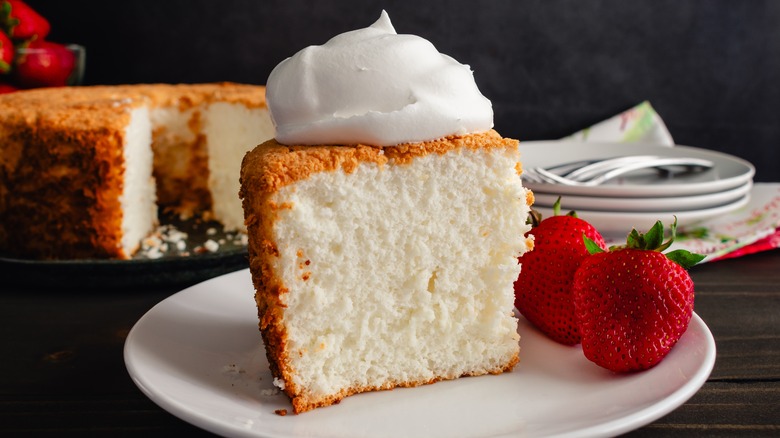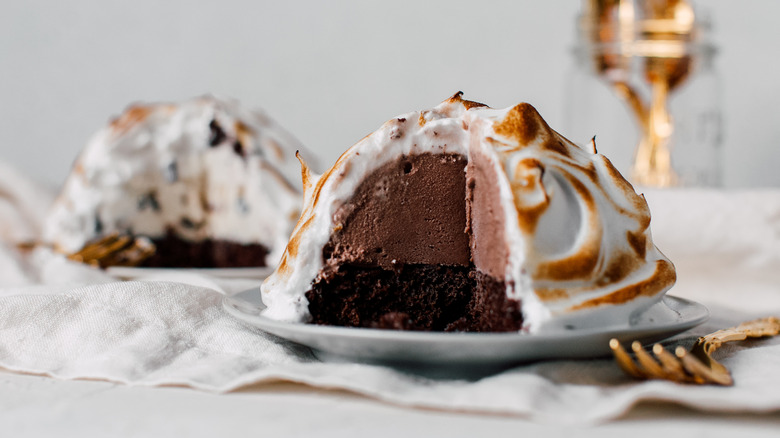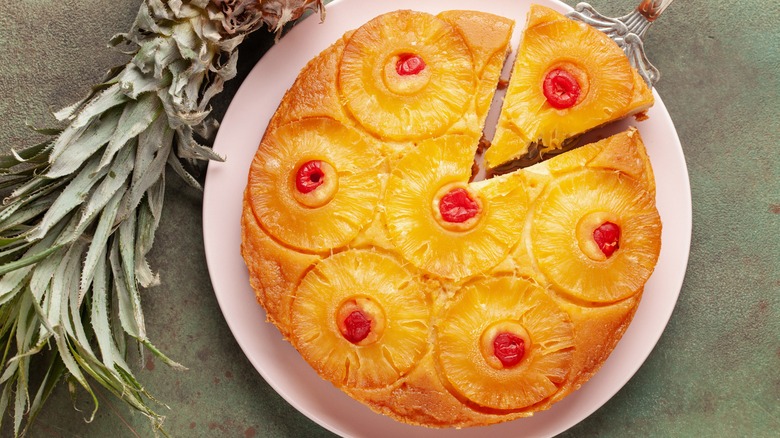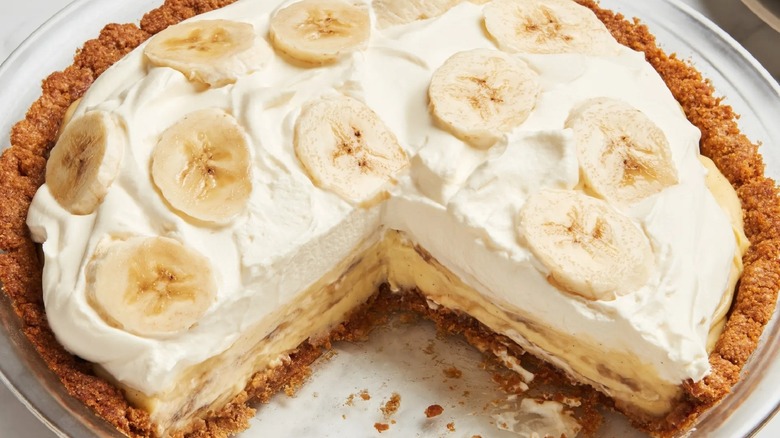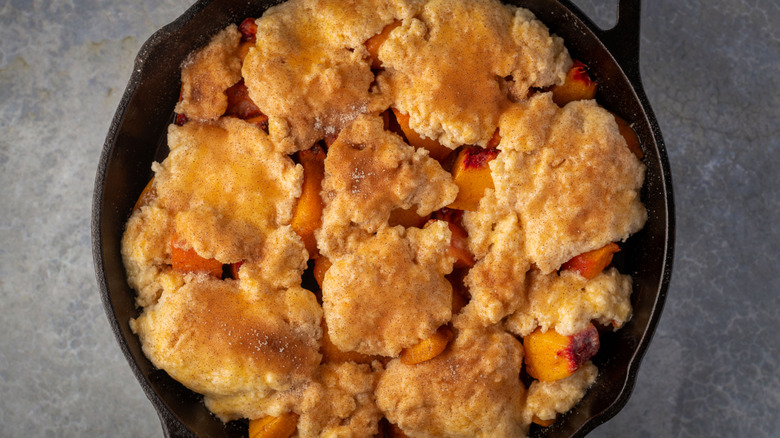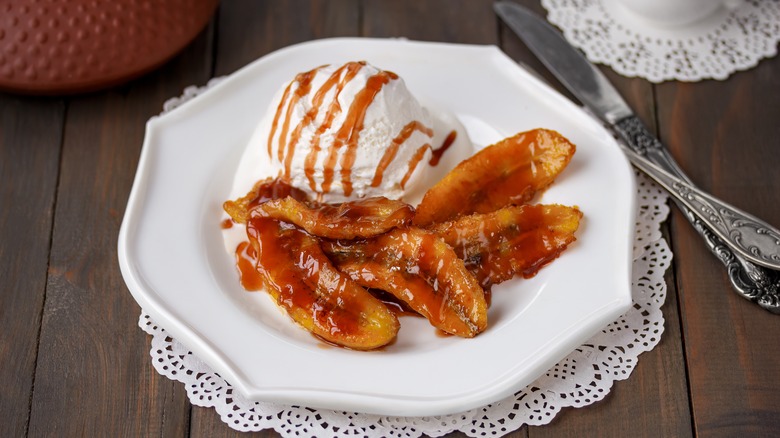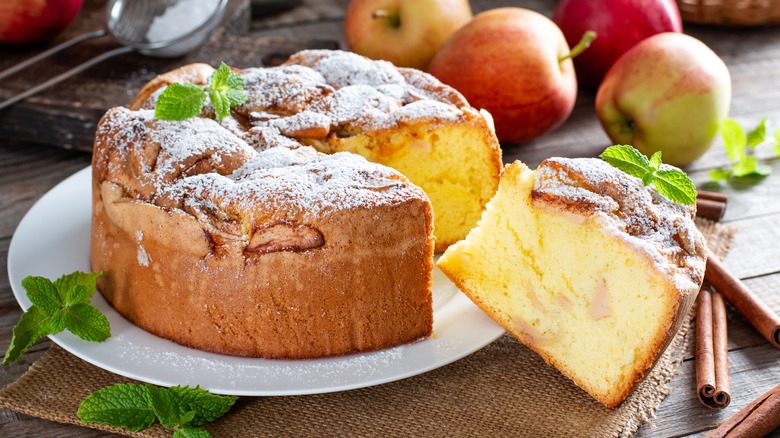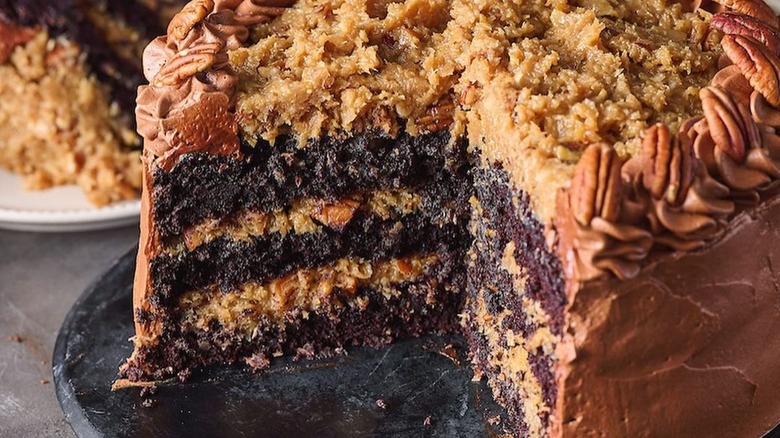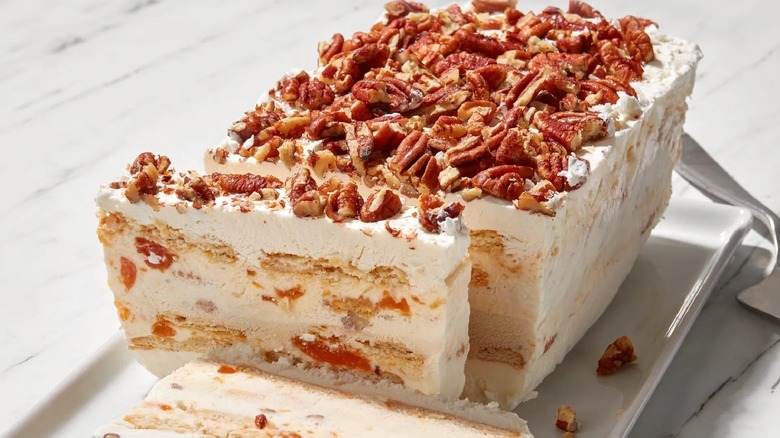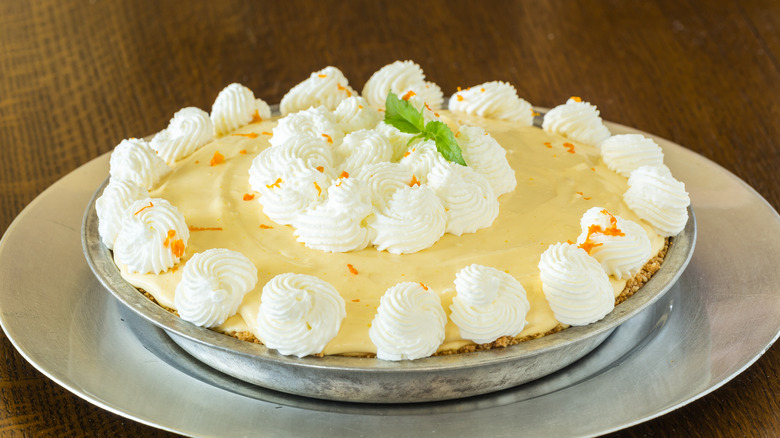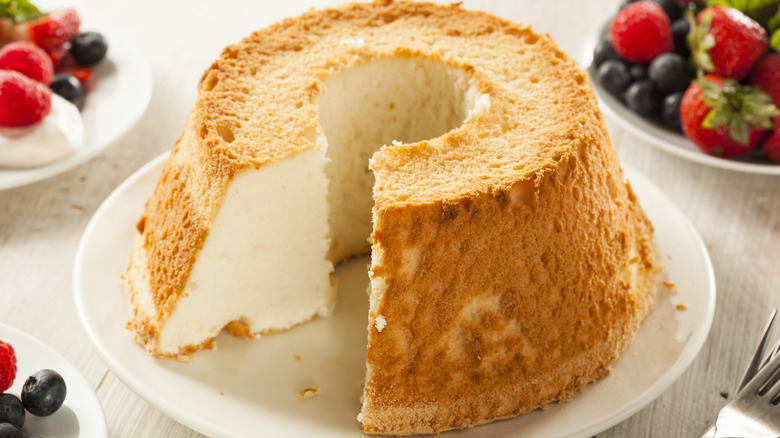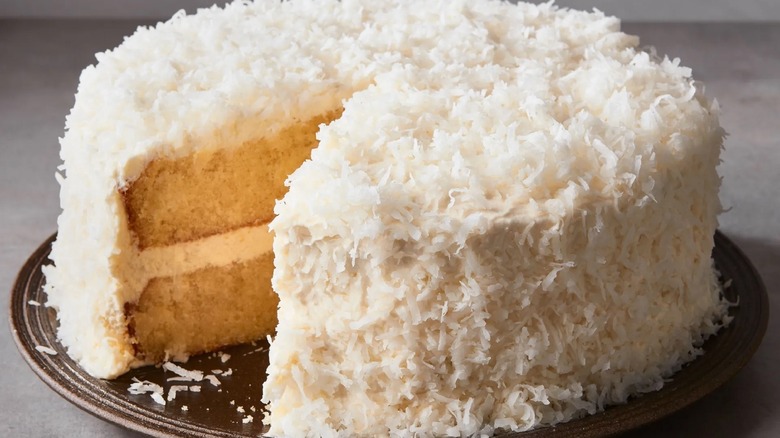11 Popular 1950s Desserts That Are Still Crowd Pleasers
The 1950s was a wild decade for food. These postwar years were marked by a sense of abundance, domestic luxuries, and convenience. TV dinners first made an appearance in 1953, and frozen food soon went mainstream. It wasn't just main courses that were leveled up during the '50s, either. Desserts reached a whole new level of extravagance, with intrepid chefs championing sweet treats that incorporated a combination of processed and fresh food items to make culinary mash-ups. Others realized the pleasures of older desserts and thrust them to the forefront of American culture.
However, like many foods throughout history, not all of these desserts stood the test of time. Some, like Jell-O salads or the somewhat vomit-inducing tomato soup cake (championed by the Campbell Soup Company in 1958), have rightly receded to the history books and are now considered niche, retro inventions. Others may surprise you, though. There's a whole host of desserts that were popular during the 1950s that you can still find on menus today — and while some may have a vintage feel to them, you can guarantee that pulling them out at a party will still impress the masses.
1. Baked Alaska
Perhaps the most show-stopping of all desserts on this list, baked Alaska first hit its stride in the 1950s. Interestingly, this physics-defying sweet had already been around for a while. Its roots stretch all the way back to the 18th century, when scientist Sir Benjamin Thompson discovered the insulating qualities of egg whites. This led to the creation of the baked Alaska in the 1800s.
It wasn't until the 1950s, though, that this dessert went mainstream. The baked Alaska became associated with cruise ships during the decade, and soon spread to home kitchens, where cooks harnessed the new power of home freezers and electric mixers to put them together. Pretty soon, the baked Alaska (also known as the bombe Alaska) was on the cover of magazines, and became the must-have dish of the decade.
It's fair to say that the baked Alaska's heyday has passed. Nowadays, most people revert to another dessert instead of tackling this complex construction of meringue, ice cream, and cake (we don't blame them — these things are hard to make). However, you can still find them on restaurant menus, and whipping one up for your friends will definitely generate gasps of appreciation.
2. Pineapple upside-down cake
Desserts don't get more kitschy than the pineapple upside-down cake. This dish is the very picture of the 1950s: A soft sponge studded with pineapple rings and maraschino cherries, it screams vintage deliciousness. But though the dish was massive during this decade, it was actually invented several decades before.
Upside-down cakes started to appear in the late 19th century, but they tended to use homegrown fruits like apples and cherries. In the 1920s, food company Dole started to sell canned pineapple. As part of a mission to promote the product, the company announced a competition for the best canned pineapple recipes. Pineapple upside-down cake came out on top, leading Dole to advertise the recipe. By the end of the 1950s, virtually everyone knew what a pineapple upside-down cake was, and most of them had tried it at least once.
Pineapple upside-down cakes were never destined to be restaurant fare, so it's little surprise that they're difficult to find in eateries. Let's be real, though: This dessert is still totally delicious, and its simplicity makes it appealing to this very day. Don't believe us? Try making a pineapple upside-down cake yourself.
3. Banana cream pie
Banana cream pie may be a pretty retro affair nowadays, but there was a time when this dessert was of the moment. Like many other desserts that were widespread in the 1950s, banana cream pie's popularity didn't happen overnight. The pie's origins date back to the end of the 19th and the start of the 20th century, with a recipe for it appearing in the "Woman's Exchange Cook Book" in 1901. However, it was in the '50s that banana cream pie really started to take off. It became particularly popular with United States soldiers, who went so far as to vote the pie as one of their top choices for dessert.
Nowadays, banana cream pie's legacy lives on, if in a somewhat diminished capacity. If you're in the mood to celebrate this iconic dish, it even has its own day: National Banana Cream Pie day falls on March 2 each year. Its influence has spread beyond the US, too. In the United Kingdom, banoffee pie is a similarly retro dessert that's closely related to banana cream pie; it combines the latter's trio of whipped cream, bananas, and a buttery base with thick caramel sauce.
4. Peach cobbler
Peach cobbler may be a distinctly Southern recipe, but many have tried it (and loved it) far beyond the region's borders. It's a testament to this dessert's deliciousness and ability to stand the test of time that it's almost as popular today as it was in the 1950s. Back then, peach cobbler was a sensation, thanks largely to the Georgia Peach Council. The council decided to designate April 13 National Peach Cobbler Day as a means to promote the sales of canned peaches at a time of year when they were out of season.
The council's promotional activities worked. Peach cobbler took off, and the combination of delicious peaches topped with a crumbly, crunchy lid began to be seen on more and more tables around the country. Interestingly, peach cobbler and other types of fruit cobbler were around long before the '50s rolled around. The dessert was invented many decades prior, and was actually not exclusively considered a dessert in its earliest forms. Originally created by 19th-century settlers, cobbler was often eaten as breakfast or even a main dish. By the end of the 19th century, however, it had firmly landed as an after-dinner treat.
5. Bananas Foster
Brennan's, the iconic Creole restaurant situated in the French Quarter of New Orleans, has a major claim to fame: It played a big role in bringing Bananas Foster into the world. In the early 1950s, chef Paul Blange was presented with a challenge by Owen Brennan, the namesake of Brennan's restaurant. Brennan was trying to find a way to incorporate bananas, which were arriving into the city in ever-larger quantities, into a dish. Blange put his thinking hat on, fired up his pan, and came up with Bananas Foster, a rum-and-cinnamon soaked dish of flambéed bananas which is dished up with a generous scoop of vanilla ice cream.
Pretty soon, Bananas Foster was the talk of the town, and the entire country caught on shortly afterward. The dish, which was named after local business leader Richard Foster, became a staple on the Brennan's menu, where it remains to this day. The restaurant gets through roughly 35,000 pounds of bananas each year to keep up with the demand for its dish. While going to Brennan's may be the best solution to try Bananas Foster in its most classic form, you can still find it dotted around the country at various eateries.
6. Chiffon cake
The chiffon cake is, in many ways, the very picture of the 1950s. This light, delicate cake is unfussy, yet elegant, and has a close relationship to the one and only Betty Crocker. Chiffon cake was invented several decades beforehand by Harry Baker, an insurance salesman who turned his hand to baking and created the cake in 1927. Baker's original client was the Brown Derby restaurant, the iconic brown-domed Los Angeles eatery well-known for being a favorite of various stars during the Golden Age of Hollywood.
When Betty Crocker came knocking, however, everything changed. Baker sold his recipe to General Mills in 1947, and the following year, chiffon cake started to be promoted by the Betty Crocker line. Countless people got their hands on the recipe, and the cake had an explosion of popularity during the 1950s. Chiffon cake's appeal slightly waned over the years, but it had a resurgence towards the end of the 20th century. Nowadays it's one of those cakes that you can find everywhere. It's simple to make at home, too, which keeps it popular.
7. German chocolate cake
Now, let's start with a big reveal: When we talk about German chocolate cake, we're not talking about chocolate cake from Germany. Instead, we're talking about the moist, sticky-sweet combination of chocolate sponge and coconut pecan frosting named after Sam German, the creator of "German's Chocolate."
German (who, again, was not German — we know, we're confused too) invented the sweet baking chocolate in the 1850s, but its use came into its own in 1957, when a home cook sent her recipe for German chocolate cake to The Dallas Morning News. It's no exaggeration to say that people went wild for the recipe. It swept across Dallas, and then the whole country, with German's Chocolate sales spiking considerably.
From there, the popularity of German chocolate cake never really died down; what started in the 1950s continues to this very day. If you want to make an authentic German chocolate cake, go for Baker's German's Sweet Chocolate, which can be found in most large supermarkets. However, any sweet baking chocolate can do the trick, and your cake will be just as delicious.
8. Icebox cake
Ah, the icebox cake. This ultra-retro dessert is the very picture of the 1950s, and spoke to the love of modern conveniences that were a hallmark of the decade. The '50s built on the refrigerator in a big way: While this appliance was used widely in homes by the time the '50s rolled around, increased technological advances throughout the decade made the humble fridge something a little more exciting. When this was combined by the sudden increase in convenience foods like pudding and cake mixes that spiked during the 1950s, the icebox cake (which was invented a few decades before) took off in a big way.
The icebox cake was a staple of countless households during the era, primarily because of how easy it is to make. All you have to do is create a graham cracker base and spoon on pudding mix. You then top it with frosting (which, in true '50s fashion, was often canned) and leave it to sit in your icebox until it firms up. While icebox cakes are undeniably delicious, their slightly unrefined nature meant that they kinda fell out of fashion after the '50s. However, in recent years, people have come back around to their convenience. Indeed, some chefs have found a way to make icebox cakes that don't just rely on prepackaged ingredients.
9. Lemon chiffon pie
While they use the same word in their names and were both popular during the 1950s, it's important to remember that chiffon pie and chiffon cake are not the same. Nor is a lemon chiffon pie the same as a lemon meringue pie, although they're often mistaken for each other. Lemon chiffon pie is instead a dish of its very own — a light pie made from a mousse-like lemon filling which is made with whipped egg whites and gelatin. The mixture is folded into a pie crust and topped with whipped cream.
Its understated elegance made lemon chiffon pie a real hit in the 1950s. It was often served in diners and restaurants, but was just as good when made at home. The pie was originally invented in 1926 by Monroe Boston Strause, a pie expert who came to be known as the "Pie King," and was, in many ways, one of the first celebrity chefs. Although the lemon chiffon pie's popularity was somewhat overtaken by other lemony desserts (particularly the lemon meringue pie), it still hits the mark today.
10. Angel food cake
There are few people out there who don't know what angel food cake is, and even fewer who don't enjoy it. This lighter-than-air cake is tasty, delicate, and infinitely adaptable: It can be eaten on its own, or incorporated into countless other cake recipes. It really took off in the 1950s, thanks to an American icon: Betty Crocker.
Betty Crocker was (and still is) a byword for cake during the era, thanks largely to the publication of "Betty Crocker's Picture Cook Book." This book, which was published in 1950, acted as the one-stop-shop for millions of Americans who were learning to flex their muscles in the kitchen, and was abundant with cake recipes. These included, naturally, angel food cake and variations like angel food Waldorf cake, which consisted of an angel food cake stuffed with chocolate filling.
It's hard to overstate the importance of "Betty Crocker's Picture Cook Book." Over the years, the book has been reprinted and reissued multiple times, and has sold more than 75 million copies. Its easy, accessible recipes made anybody feel like they could bake like Crocker herself (even though Betty Crocker isn't actually real), and it shaped much of our food culture today; angel food cake is still a staple in households around the country.
11. Coconut cake
Coconuts and cake are an iconic combo; these days, many bakeries sell some form of coconut cake. This simple, yet endlessly appealing treat is pretty versatile, but generally consists of a white or yellow sponge, sometimes with layers of cream inside, covered in frosting and studded with coconut flakes. Although the origins of this cake stretch back to the early 1800s, it generated wider momentum during the 1950s thanks to its presence at Howard Johnson's.
One of the enduring icons of the '50s and beyond, Howard Johnson's was a highly popular roadside stop for families on the move. Its diverse menu could please virtually every palette, but it was the desserts that people really loved. Coconut cake was a key offering at the restaurant chain (which sadly lost its way throughout the latter half of the 20th and start of the 21st century, and wound down its operations considerably), and its reliability and deliciousness did wonders for its appeal. Luckily, while Howard Johnson's restaurants aren't the staple they once were, coconut cake still endures.
